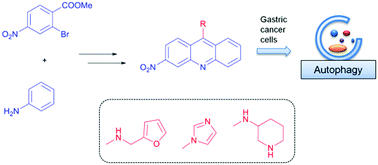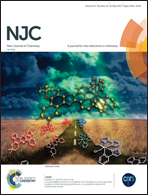Identification of novel 3-nitroacridines as autophagy inducers in gastric cancer cells†
Abstract
Dysregulated autophagy is involved in various human disorders including cancer. An autophagy-associated cell death pathway can be seen as a back-up cell death mechanism in cancer cells that are deficient in the apoptosis pathway. Therefore, many attempts have been made to induce autophagy for anticancer therapy. Anti-apoptotic Bcl-2 family proteins Bcl-2 and Bcl-xL can inhibit autophagy via binding to the BH3-only protein Beclin 1, an essential autophagy stimulator. In a previous study, we discovered several small molecule Beclin 1 mimetics as autophagy inducers through high-throughput screening and structural optimization, in which 3-nitroacridine warrants further exploration. Here, a series of novel 3-nitroacridine derivatives were designed, synthesized, and their pharmaceutical activities and mechanism of action were investigated against gastric cancer cell lines. As a result, compounds 3, 4, and 9 displayed potent cytotoxicity and induced autophagy in MGC-803 and SGC-7901 gastric cancer cells. Besides, compounds 3 and 9 also inhibited the migration of SGC-7901 cells. The development of 3-nitroacridine analogues as autophagy inducers is not only likely to be a potential strategy for cancer therapy, but it will also facilitate a better understanding of the complicated roles of autophagy in normal physiology and pathophysiology.



 Please wait while we load your content...
Please wait while we load your content...